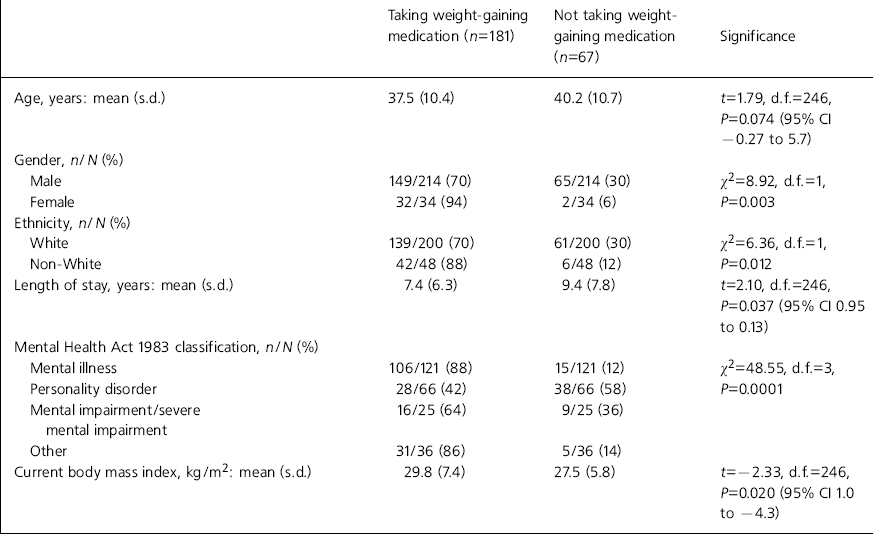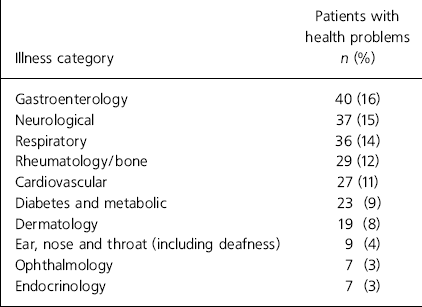The Department of Health has made improvement of the physical health of the population of the UK a priority. Chronic psychiatric disorders are associated with increased morbidity and premature mortality. The standardised mortality ratio of patients with schizophrenia is nearly three times that of the general population; 60% of the excess mortality can be attributed to the same broad range of conditions that cause deaths in the general population (Reference Brown, Inskip and BarracloughBrown et al, 2000). The poor physical health of psychiatric patients has been attributed to decreased health awareness, fewer opportunities for a healthy life-style, high rates of smoking and the health risks associated with some psychotropic medications (Reference Harris and BarracloughHarris & Barraclough, 1998).
Our study was designed to evaluate the physical health of the patient population and health risk factors in long-stay psychiatric patients in a high secure hospital.
Method
A cross-sectional survey of the patients at Rampton Hospital was undertaken between November 2000 and March 2001. The local research ethics committee approved the study. We obtained permission from the ethics committee and the Caldicott Guardian to compare the interviewed patients and non-interviewed patients on key demographic variables. Permission was given to use data held on the Special Hospitals’ Case Register; a database holding information on all patients admitted to Special Hospitals since 1972.
Two researchers (I.C. and R.B.) invited patients to take part in the study. Patients were not approached if their mental state was too disturbed or if they were deemed incapable of giving informed consent. After obtaining written consent, the researchers conducted a semi-structured interview and examined the case notes, collecting information on smoking habits, past history of physical illness, current health problems and current psychotropic and non-psychotropic medication. The Maudsley criteria (Reference Taylor, Mcconnell and McconnellTaylor et al, 2001) were used to determine whether the patient's psychotropic medication carried a risk of weight gain. We noted the psychiatric diagnoses according to ICD-10 criteria (World Health Organization, 1992).
Central deposition of adipose tissue increases health risk, and waist size is positively correlated with abdominal fat content. Health risks in men are increased if waist size exceeds 94 cm, and an intervention is needed if waist size exceeds 102 cm. For women, waist sizes greater than 80 cm increase health risk and sizes greater than 88 cm require intervention (Reference Lean, Han and MorrisonLean et al, 1995).
Measurements were taken of height, weight, waist circumference and blood pressure using standard equipment, and body mass index (BMI) was calculated.
Results
Demographics
The hospital population comprised 460 patients, of whom 31 were on trial leave, 22 were unable to give informed consent and 159 refused to participate. Of the 248 patients who agreed to be interviewed, 214 were men and 34 were women. Most patients in the sample were White (200 of 248).
The age of interviewed patients ranged from 20.3 years to 80.7 years (mean 39.0 years, s.d.=10.75). The length of stay of the patients ranged from 0.02 years to 46.20 years (mean 8.93 years, s.d.=7.98). The Mental Health Act 1983 classifications of the sample were: 121 (49%) mental illness, 66 (27%) psychopathic disorder, 25 (10%) mental impairment or severe mental impairment; 36 (14%) had dual classifications.
The majority of the interviewed patients (131/248) had schizophrenia and 119 had disorders of adult personality and behaviour. There were 59 patients with mental retardation (learning disabilities), which may be associated with increased vulnerability to physical illness and communication difficulties and thus compromise access to physical healthcare. More than one form of mental disorder was present in 115 patients.
Comparison of interviewed and non-interviewed patients
There was no significant difference between the interviewed and non-interviewed patients in terms of age, gender, ethnicity, Mental Health Act 1983 classification or on data collected on admission on smoking habits, alcohol problems and BMI. Non-interviewed patients had a significantly greater mean length of stay than the interviewed patients: 10.14 years (s.d.=9.04) compared with 7.90 years (s.d.=6.80); t=12.97, P=0.003, 95% CI –3.73 to –0.76. This finding was not significant when patients on trial leave were eliminated from the analysis.
Smoking
Seventy-one per cent of both male patients (152/214) and female patients (24/34) reported smoking tobacco, compared with 28% of the combined male and female general population; 63% smoked loose tobacco (155/248). The average daily consumption of cigarettes or cigarette equivalents was 15.6. At this rate of tobacco consumption, an individual is 13 times more likely to die prematurely than a non-smoker (Action on Smoking and Health, 2002).
Obesity and body shape
The rate of obesity in the hospital sample was 36% in men and 75% in women. This should be compared with rates of obesity in the UK population of 17% in men and 22% in women (Reference Peterson, Raynor and PressPeterson et al, 2000). Just three patients (1.2%) were underweight.
Where data were available in the Special Hospitals’ Case Register, we compared weight on admission with current weight. This showed that 70 of 430 (16%) patients were admitted to Rampton Hospital with a BMI of 30 kg/m2 or over. There was a substantial increase in weight in most patients during their admission. In women the mean gain was 12.74 kg (s.d.=17.02) and in men it was 10.62 kg (s.d.=17.19).
Regarding waist size, 112 of 214 (53%) of male patients and 26 of 34 (76%) female patients in the sample had a waist size that required an intervention to reduce health risk. The mean waist size in male patients was 103.1cm (s.d.=14.4, range 68.5-156) and in female patients it was 110.0 cm (s.d.=18.8, range 77.0-143.0). Both of these means fall in the category of risk for which an intervention is recommended.
Body mass index and psychotropic medication
Table 1 shows the relationship between current medication and age, gender, ethnicity, length of stay, Mental Health Act 1983 classification, current BMI and weight change since admission. Those taking medication associated with side-effects of weight gain were significantly more likely to be female, non-White, to have a shorter length of stay, a classification of mental illness and a higher mean BMI. There was no significant relationship with BMI increase since admission.
Table 1. Comparison of patients taking medication with potential for weight gain and those not taking such medication

| Taking weight-gaining medication (n=181) | Not taking weight-gaining medication (n=67) | Significance | |
|---|---|---|---|
| Age, years: mean (s.d.) | 37.5 (10.4) | 40.2 (10.7) | t=1.79, d.f.=246, P=0.074 (95% Cl -0.27 to 5.7) |
| Gender, n/N (%) | |||
| Male | 149/214 (70) | 65/214 (30) | χ 2=8.92, d.f.=1, |
| Female | 32/34 (94) | 2/34 (6) | P=0.003 |
| Ethnicity, n/N (%) | |||
| White | 139/200 (70) | 61/200 (30) | χ 2=6.36, d.f.=1, |
| Non-White | 42/48 (88) | 6/48 (12) | P=0.012 |
| Length of stay, years: mean (s.d.) | 7.4 (6.3) | 9.4 (7.8) | t=2.10, d.f.=246, P=0.037 (95% Cl 0.95 to 0.13) |
| Mental Health Act 1983 classification, n/N (%) | |||
| Mental illness | 106/121 (88) | 15/121 (12) | χ 2=48.55, d.f.=3, |
| Personality disorder | 28/66 (42) | 38/66 (58) | P=0.0001 |
| Mental impairment/severe mental impairment | 16/25 (64) | 9/25 (36) | |
| Other | 31/36 (86) | 5/36 (14) | |
| Current body mass index, kg/m2: mean (s.d.) | 29.8 (7.4) | 27.5 (5.8) | t=-2.33, d.f.=246, P=0.020 (95% Cl 1.0 to -4.3) |
There was no statistical difference between the mean waist size for women taking medication with a risk of weight gain and women not taking medication or taking medication with no risk of weight gain. Male patients taking medication with a risk of weight gain had a statistically significant greater mean waist size (t=72.874, P=0.004) than male patients on no medication or taking medication with no risk of weight gain.
Hypertension
We found that 103 (48%) of the 214 interviewed male patients and 3 (9%) of the 34 interviewed female patients might be at risk due to hypertension. In comparison, the levels of hypertension in the British population are 41% of men and 33% of women (Reference Britton and McphersonBritton & McPherson, 2002).
General patient morbidity
We found that 90 (36%) of our sample reported being breathless after climbing one flight of stairs; 134 (54%) had one or more diagnosed significant health problems. Table 2 shows the number and percentage of patients with health problems in the ten most frequently reported medical categories.
Table 2. Medical conditions of patients interviewed

| Illness category | Patients with health problems n (%) |
|---|---|
| Gastroenterology | 40 (16) |
| Neurological | 37 (15) |
| Respiratory | 36 (14) |
| Rheumatology/bone | 29 (12) |
| Cardiovascular | 27 (11) |
| Diabetes and metabolic | 23 (9) |
| Dermatology | 19 (8) |
| Ear, nose and throat (including deafness) | 9 (4) |
| Ophthalmology | 7 (3) |
| Endocrinology | 7 (3) |
Discussion
Owing to the cross-sectional design of the study, it was not possible to determine the aetiology or development of the physical health problems. No invasive procedures were undertaken, such as measurement of cholesterol levels, as this might have deterred patients from participation in the study. We could not measure levels of physical activity. Blood pressure measurements should be taken at least three times before a diagnosis of hypertension is made. However, we were only able to make one measurement for each patient. The patients’ recall of past health problems might have been biased by their current mental and physical health status (selective recall bias).
The study findings have raised serious concerns about avoidable health risks in a population of long-stay psychiatric patients. These risks include high rates of smoking, obesity, central weight distribution and excessive weight gain. The results of this study should be seen in the context of increased health risks, morbidity and mortality in psychiatric populations elsewhere and in the general population.
There are well-developed and proven strategies for decreasing health risk factors that could be implemented in long-stay psychiatric facilities (Reference Cormac, Ferriter and MartinCormac et al, 2004). Since the completion of this study, Rampton Hospital has developed interventions for health promotion for long-stay psychiatric patients. Further research is needed in this important area of patient care.
Psychiatric hospitals have a responsibility for the physical health of their patients. Hospitals should promote healthy living and provide the same standard of healthcare that is available to the general population. This paper shows the need for the provision of primary care services and health promotion for psychiatric patients with mental disorders.
Declaration of interest
None.





eLetters
No eLetters have been published for this article.